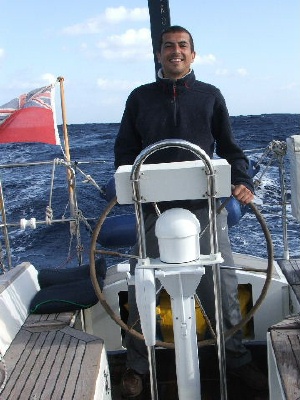
Adam at the helm and on watch in the Atlantic
Living the Dream, part 8
The Atlantic Crossing
It would be very easy to quote verbatim from the yacht log every decision that was made, every sail change, wind change (in speed and direction) and what we had to eat for meals, but I prefer to précis all of these events and highlight some of those moments, which stick out in our memory during the 22 days and 6¼ hours, which it took us to sail from La Gomera to Carlyle Bay in Barbados. There is no doubt in my mind that we were ready for the voyage in fitness, strength, vitality and preparation. It was a first for all three of us and we all realised that once we were out of sight of land, we were on our own and would have to rely upon ourselves as a team.
The first decision made was for a 24-hour watch system to operate throughout the voyage, with each member of the crew being on watch for 3 hours and off watch for 6 hours. Either or both of the off watch crew could be recalled to watch duty in the event of any necessity for assistance. This system worked very well and enabled all to have as much sleep as we required, although there were some times when sleep was not possible due to the wind and uncomfortable swell. We also ran this system during the day, so that there was no doubt as to who was on watch at any time.
My passage plan was simple, in that we would sail a course of 210º T ( 220º M) for 660 miles to waypoint N 18º 30’ W 23º 00’. We would then alter course to 260º T (with variable magnetic variations). By heading south for 660 miles, we were almost guaranteed to eventually run into the trade winds.
Having set off in positive mood, goose-winged in a NE breeze, our humour was dampened by the fact that the wind came around to SW and even then we only had about 4-5 knots of wind, so we found ourselves motoring throughout the afternoon and evening to clear the Canaries and the calms, which are to be found south of that group. By 2300, we were sailing with a following NE breeze with our favourite combination of full working jib and full main on a broad reach. Despite our inauspicious start, we managed a creditable 120 miles for the first 24 hours.
Angling for dorado
Just after lunchtime on the second day, Siobhán and Adam caught their first fish, a 6-10 lb (3-5 kg) dorado (dolphin fish), which I killed, cleaned and filleted. It was delicious and provided meals for two days. Shortly afterwards, Adam spotted a turtle basking in the sun just off our port side. At 2230, dolphins swam around the boat, as a good luck omen.
Later on that evening, two large ketches passed over our course heading west. For the next 3 weeks we saw only one other yacht and that on the horizon. None of them answered our calls on the radio. Obviously shy.
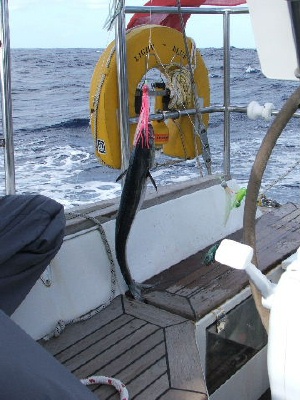
Dorado (dolphin fish) on the menu tonight
Our wind for the second day became a steady NE 4/5, which was good news and distance made good increased to 140 miles. On the third day, it increased to force 6 and stayed that way, with gusts up to 34 knots, which made for excellent fast sailing, with 150 miles distance made good on day 4.
I wrote in the log, ‘After a sound sleep of 6 hours, I have now been on watch for 4 and a half hours and I am exhilarated by the wonderful sailing. With two reefs in the main and half working jib, we are zooming south-west at between 6 and 8 knots. I am delighted that the boat is so well balanced as she soars down the swell, surfing at up to 8.3 knots. The sea is rough due to the constant force 5-7 wind, but we’re not taking much over the deck. I have just seen a small bird (a Shearwater perhaps) and it raised my spirits even higher, because I haven’t seen a bird for days. We’re progressing very well and I hope that these constant high winds continue without putting strain on the boat, rigging or us. It would be perfect if Hal the Hydrovane pulled his weight, but he baulks at the cross swell.’
Adam, in fact, tamed the hydrovane finally and it became the fourth member of the crew for hundreds of miles.
Things don’t always go smoothly, however, but if a problem is seen early enough, it can be sorted quickly and will not develop into a severe drama, which I suppose, is true of most things in life. Anyway, at 2310 on the fourth day out, as Siobhán assisted Adam in reducing the size of the working jib, the furling line became spaghetti around the furling drum at the bow. The wind was increasing, noise getting loader, but we switched the deck light on and I went forward to the bow and eventually together we unravelled the mess and reduced the size of the jib. Twelve hours later I wrote in the log, ‘The end of our fourth day at sea and everybody is well rested, well fed and delighted with our 150-mile noon-to-noon passage — long may it continue.’
On 9 December, at 0315, I was on watch in the pitch black, when I heard a gentle fluttering sound, like a bird’s wings. I turned on the cockpit torch and saw in the torchlight, in the area by the genoa sheets, a flying fish flapping its wings and fins furiously. Torn between humanity and a possible snack for breakfast, I got a fish slice from the galley and gently restored him to the deep. Thereafter, along the way, we found many dead flying fish along the side decks. One even found its way inside the spray hood, and on one occasion Adam was sitting on watch in the dark, when one hit him on the cheek, giving him a nasty shock.
Apart from dolphins, they were the only fish we saw. As we sailed through the ocean, they would scatter before us in ones and twos and sometimes in schools of flight and they would dance across the waves, skimming like the stones we threw from the beach as children, until they plunged once more into a wave and disappeared from view with an unceremonious splash. Null point for their diving ability.
I have written against 9 December, ‘Far from blue-water sailing, although the NE force 5/6 wind is quite warm, the sky is overcast all day and the ocean swell grey. Squadrons of stern steel swells strafe our starboard quarter with spray. One after the other they roll majestically beneath us and disappear into the distance foam-backed at a speed which knocks spots off our 7.5 knots. We are at present heading west along the N 18º 30’ line in the hope that the trade winds proper will replace these helpful NE 5-7 breezes and near gales. I’m not complaining as it is driving us toward our destination faster. While the others are resting below.
‘I am recording this in the cockpit to the swish and roar of the ocean and the whirr of the water-driven generator, towed behind. Another monstrous swell towers above our stern threateningly, then meekly slips beneath the boat with a "hiss" hello and a roar "goodbye". It is really awe inspiring to be hundreds of miles from land, propelling this little ship across the ocean by the skill of trimming the sails and navigation par excellence (and GPS off course — I mean of course).’
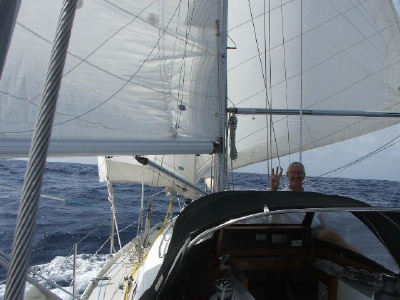
Three sails a-running
At midnight on the 10th we are sailing with main (with two reefs in), the sea is rough and wind is gusting to 34 knots. At 0740, I was on watch sitting in the pilot’s seat, when the cockpit was unexpectedly pooped (completely filled from behind), which filled the cockpit and ran down the companion way steps. I was wearing my wet weather gear and got completely waterlogged. I placed the boards in for future poopings, but they never occurred. Recorded in the log for the 11th is ‘Our distance made good for the 7 days since leaving La Gomera is 930 nautical miles. This is excellent.’
Also on the same day, I wrote, ‘I believe that our autohelm motor (for the hydraulic pump) has given up the ghost as it will not hold or correct a course.’ I put this down to the inability to balance the sails, because of the severe NW cross swell, which was putting so much strain on the pump. Thereafter, we used Hal the Hydrovane with virtually no problems.
The next day I wrote, ‘Adam has tuned Hal up so efficiently that we are sailing along our track evenly, keenly and fast. The weather has been grey, overcast and with force 5-7 winds, which has provided a severe cross swell of NW, NE and E swells. This makes living below difficult, noisy and at times dangerous. Luckily none of us have sustained injuries, due to our dedication to safety (in particular our own). Today the clouds have cleared away and we are ailing under the same conditions as before but in very welcome sunshine. I am in shorts for the first time in days.’
Swab the deck!
We had put up the storm trysail in lieu of the mainsail and I wrote, ‘The 1/3 working jib and storm trysail makes for easy, safe and reasonably fast sailing. Siobhán’s cooking has been imaginative, well-balanced, tasty and nutritious, with little or no waste, except for some overripe fruit and veg. Siobhán is showering, Adam is reading his "Sound on Sound" magazine in the cockpit and I am writing this log with the sun and warm stiff breeze brushing my back.
‘It is good for teak decks to be kept watered every day in the tropics as they tend to dry out and this has been no problem since the cockpit has been swamped several times. The advantages of the open stern is that the hundreds of gallons of sea water empties out very quickly. The various untimely dousings are a source of great amusement to the untouched witnesses. Blue skies and sunshine make such a difference to the mood of the boat. Although all three of us have been cheerful for most of our waking hours, the heat and cheering blue sky imbues in all of us an ebullience. Optimistically, Adam said, "Wouldn’t it be great if we had this much wind all the way" (20-23 knots).’
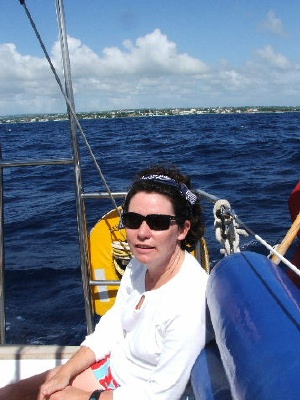
Siobhán in pensive mood
To clear up any doubts about how Siobhán was showering in the middle of the Atlantic, you will remember that we have a water-maker on board. We have a tank of fresh water holding 396 litres (80 gallons). We run the engine daily for a couple of hours to charge up the service and navigation batteries and while we are doing that we make fresh water from sea water by a method of reverse osmosis. The water-maker produces about 35-45 litres of fresh water per hour. At the same time as the engine is running, it heats a certain amount of water, so it is possible to have a piping hot shower at any time. Some times it is necessary to wash off all the salt, which becomes caked in one’s hair and clothes. We certainly didn’t shower every day, but the water-making system came up trumps after all its problems. So that it doesn’t get overworked, when we are not making water, I change the three pulley belt for the two pulley belt. This system works and only takes me 5 minutes to change belts.
After a week, we found that we had all settled well into the boat life, the motion and living above and below decks, plus the regime of the watch system. We were living a 24/7 week with the 3-hour/6-hour watches and we were all looking well for being exposed to the open air constantly, since we are never ‘indoors’, but always in the open air. After a meeting we agreed that it would be fair to rotate the cooking between the three of us and also, Siobhán and Adam wanted a chance to get some ‘skipper’ experience and miles in, so we introduced a very simple change to the watch system, which worked thereafter very well and everyone found it fair. Suffice it to say that we all had successes and failures in the culinary line, but Siobhán’s cooking was always the best.
Week 2
And so the voyage entered its second week and we turned west to a course of 264º True (280º Magnetic). On the 16th, I wrote in the log, ‘Sitting in the cockpit (Adam reading a novel, Siobhán asleep below). Beautiful sky, doing 6.8 knots all sails full. At this rate we will be in Barbados by 26 December 2006 or sooner. It has been a strange 24-hour existence in which we have seen no ships or yachts and only a handful of lone unidentifiable birds and dozens of flying fish. I hope the wind and weather continue like this as the boat eats the miles. The sea is purple at the moment and approaches us from the starboard side in giant mounds, which "Light Blue" gracefully slides over with the occasional misshapen rogue, which slews us round, rocks us and shakes the rigging.’
On the following day, we flew the cruising chute successfully, as Adam had not seen it in action. We raised it tacked it and lowered it easily using our system. It gave us about 3 knots of speed as we only had about 1.6 knots of wind at times. Adam then designed and poled out the lightweight genoa, using the spinnaker pole and a substitute genoa sheet. It enabled the LWG to fly well with the full mainsail. We ran this combination for days on end without change, albeit a little tweak now and again.
After 2 weeks we had covered 1600 miles and were chuffed with the performance of the boat and ourselves.
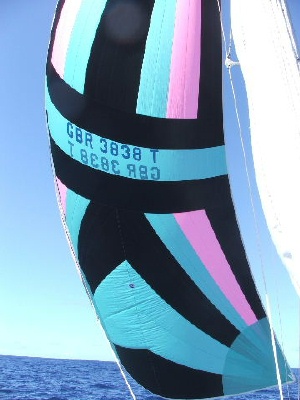
Sometimes there was barely enough
wind for the cruising chute
On 19th, I wrote, ‘Continuing to travel westwards with a little southing, which is exactly what our course requires. Blue skies, a searing sun, a tropical purple sea gently lifting us and carrying us forward and benevolently depositing us in the next valley. Blissful sailing at 5 knots+ towards our destination. Idyllic voyage in an ocean where we appear to be the only yacht. Who cares! Adam is writing his journal under the shade of the mainsail. Siobhán is still reading her book, "The Suitable Boy". I’m on watch. Easy-peasy.’
On the following day, Siobhán wrote, ‘Yacht on the horizon on our port side for the past three hours. Flying large headsail. Visited by lone big bird, similar to a gannet, but with a strange beak and white underside, dark head.’ And later that day, ‘18.30. Our first pod of dolphins since our trip to Madeira joined us for about 30 minutes. They were swimming at the bow.’
Week 3
Life proceeded gently enough through day and night for the next two days. On the 22nd, I wrote, ‘A small white egret type type bird has been circling LB and eventually after an hour landed on the genoa line. It stayed for a little while then flew off, then returned and slid down the genoa sheet to the deck and is now resting on top of the coach roof, in between the two dorade vents. At present he is staring at us through the spray hood window.’ A day later I wrote, ‘0945, Egbert the Egret left quietly without ceremony. I didn’t even hear the flutter of wings. He left behind a small reminder of his stay — a patch of guano, where he had been standing between the dorade vents.’
‘Christmas Eve: 0015, squalls for past 3 hours. Wind up to 27 knots and down to 7 knots. Some rain, very hot down below, but steady. Hal finding it difficult to cope with sudden wind changes. Needs all the help he can get. At 0230 we reduced sail to 2/3 genoa and 2 reefs in main, because of gusting wind. At 1000, blue-grey clouds with steel-grey sea. East swell with north-east cross swell. Not very comfortable down below. Magnificent red/orange sun rising.’
It might seem strange to readers that the sun is rising at 1000 hours, but one has to remember that this time is Greenwich Mean Time or Universal Time as it is known, which we keep for our boat’s log. As we are travelling across the Atlantic westwards, for every 15º that we travel west, we deduct one hour of time (Earth is 360º, which is divided by 24 hours, equalling one hour for each 15º travelled westwards. Barbados is actually 4 hours behind GMT.)
Also on 24th, a large pod of dolphins visited us during dinner, which was a splendid cheese savoury dish composed by Adam in difficult circumstances, as the swell was from many directions and was throwing us and the boat all over the place. We completed 150 nautical miles noon to noon, as we had done for many days.
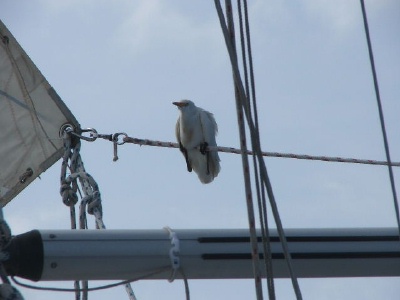
Egbert the Egret
Christmas Day: sailing as normal as we were travelling so fast and operating the same watch system. We had 170 miles still to travel to reach Barbados. Christmas lunch was at 1900, when we were all awake — a sumptuous feast of olives, bread, Serrano ham, cashew nuts, oil and vinegar, sauté potatoes, Spanish sausage, HP and beer. The winds continued to be between force 5 to 7, which is between 17 and 33 knots of wind and we continued our fast passage until reaching Carlisle Bay in Barbados at 1815 on 26 December 2006 (1415 hours Barbados time). I then had to dinghy ashore and walk to the Deep Water Harbour, where I registered with the Customs, Health and Immigration, and paid the port fees of 50 Barbadian dollars in order that we could remove our quarantine flag and begin our stay in Barbados proper. As I didn’t have the right change for the fee, I had to purchase a bottle of Barbados rum. That went down very well with Coke and lemon, when I completed my hour-long walk back to the Carlisle Bay.
At present we are sitting at anchor being gently rocked by the swell. Siobhán is cooking dinner and Adam is relaxing before he goes out for the evening. We have arranged to spend New Year’s Eve at a party on the beach with all the other yotties anchored here and a barbecue on the beach on New Year’s Day. What a life!
Siobhán, Lawry and Adam, 31 December 2006
Happy New Year
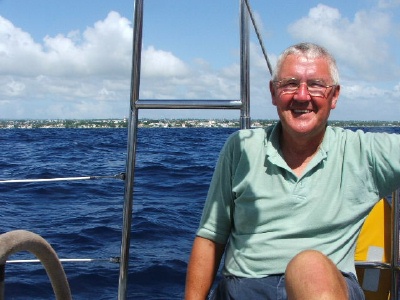
We did it!
We make landfall after 22 days at
South Point lighthouse, Barbados
